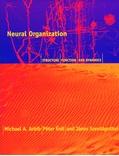Book Review 1
Neural Organization

Michael A. Arbib, Péter Érdi, and János Szentágothai
1997. A Bradford Book
The MIT Press
Cambridge, Massachusetts
Book Review
Keith H. Chiappa, M.D.
EEG Laboratory
Massachusetts General Hospital
Boston, MA
Book Review
Published:
21 May 1998
Volume 1998
Number 1
T his book is an attempt to integrate classical structural and functional aspects of brain systems with a conceptual and mathematical framework of the interactions of different levels of organization.
Part I is titled Overviews and its initial chapter reviews the concepts of structure, function, and dynamics that constitute the basic themes of the authors' approach to neuroscience. Structure refers to the anatomical aspects of the brain and the relations between different brain regions. Function refers to skills and behaviors, which are explained by functional schemas and biologically-based neural networks. Dynamics refers to a mathematical analysis of spatiotemporal neural phenomena in single neurons and networks, the development and plasticity of neural structures, and learning and memory phenomena associated with synaptic modification. The following 3 chapters expand further on these areas.
Part II is titled Interacting Systems of the Brain and uses the concepts and methods explained in Part I to analyze specific parts of the nervous system--the olfactory system, hippocampus, thalamus, cerebral cortex, cerebellum and basal ganglia. Finally, the authors propose a plan for the use of their methods in the cognitive neurosciences.
The book provides an excellent comprehensive summary of each of the areas and thus furnishes a means by which neurobiologists can learn about mathematical methods and network modeling, and those specializing in the latter disciplines can learn neurobiology. It is highly recommended to anyone wishing to explore in these directions.

